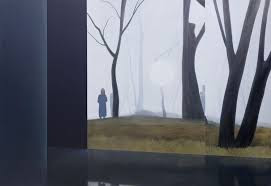Poitras was charming, and he told many stories about his youth and his career, which illuminated the designs on display. Poitras was raised by his great-grandmother in a small Quebec town, and going to mass weekly was a treat for him. He loved to look at the parade of ladies in their finery. Some of his early collections even reference ecclesiastical garments.
 |
Poitras admitted to finding inspiration in the fan magazines he loved as a child. The woolen suit on the left, designed in 1977, was inspired by Diane Keaton's androgynous wardrobe in the film Annie Hall. To my eye, the trench coat on the right is a feminine version of one worn by Humphrey Bogart in Casablanca.
Find out more about the exhibition here. The show continues until April 26, 2020.
I can imagine these frocks, shown above, on Italian film stars of the 50's and 60's.
Poitras attracted a celebrity clientele early on. He was enthusiastically endorsed by local "women of influence", like Mila Mulroney, Lisette Lapointe, and Pauline Marois.
One of the companies for which Poitras designed, Franck Imports, had extensive connections in Hong Kong. Twice a year, Poitras would spend two or three weeks in Hong Kong, learning to work with luxurious silk fabrics.
 |
The tunic shown above is cut from mud silk, a fabric made in Guangdong province in south China, since the time of the Ming dynasty. In a laborious artisanal process, silk fabric is first dyed brown with ju-liang root. One side is then coated in iron-rich mud from the Pearl River delta and the silk is left to dry flat in the sun. The mud dyes one side of the fabric black, while also giving it a slight stiffness and lustre. This method is not adaptable to industrial production.
You can see some Japanese influence in the garments above.





















